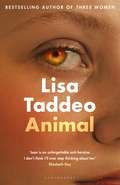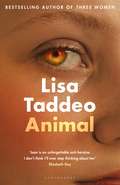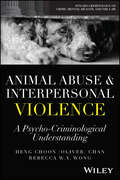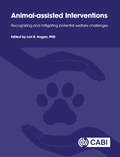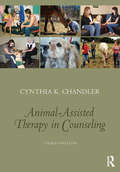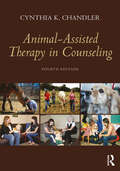- Table View
- List View
Angststörungen nach ICD-10: Manual zu Diagnostik und Therapie
by Josef Scherer Karin KuhnMit diesem Manual sollen die wesentlichen Aspekte der Angstdiagnostik nach den Forschungskriterien der ICD-10 dargestellt werden. Dabei konzentrieren sich die Autoren auf die Themen Allgemeine Angstsymptome und Differenzialdiagnose der Angststörungen. Die Darstellung lehnt sich sehr eng an die Formulierungen der klinisch-diagnostischen Leitlinien und an die Forschungskriterien der ICD-10 an.
Angstwesen Mensch: Furcht, Ängste, Angst und was sie bedeuten
by Bärbel FrischmannAngst begleitet uns überallhin und jederzeit. Sie gehört zum Menschen. Der Mensch ist ein Angstwesen, und dies prägt sein Verhältnis zur Welt, zu anderen und zu sich selbst. Um die Bedeutung der verschiedenen Ängstigungsweisen zu erläutern, wird eine Unterscheidung von drei Grundfunktionen, affektive Furcht, gefühlte Ängste und geistige Angst, vorgeschlagen. Sie stellen jeweils spezifische Ausprägungen der überlebenswichtigen Gefahrenbewältigung dar, die beim Menschen nicht nur die körperliche Schutzfunktion umfasst, sondern auch durch gedankliche Antizipation möglicher Risiken und Bedrohungen geprägt ist. Aber vor allem die Angstgefühle können aus dem Gleichgewicht geraten, als leidvoll erlebt werden und sogar pathologisch werden. Deshalb soll am Ende auch die Hoffnung formuliert werden, dass Menschen die geistige Kraft besitzen, ihre Ängste sinnvoll in ihr Leben einzuordnen. Für eine differenzierte Sicht auf die Thematik werden zum einen einschlägige Theorien von Biologie über Psychologie bis Soziologie und Philosophie herangezogen, zum anderen die gewonnenen Ergebnisse mit Blick auf gesellschaftliche, politische und ideologisch-weltanschauliche Anwendungsbereiche vertieft.
The Anguished and the Enchanted: "The Little Prince," Revisited
by M.H. BowkerIn The Anguished and the Enchanted, M.H. Bowker offers a lengthy critical essay and richly annotated English translation of a lost Finnish translation of Antoine de Saint-Exupéry’s The Little Prince. Featuring a substantial Translator’s Preface, M.H. Bowker develops a psychoanalytic lens through which to regard Saint-Exupéry’s classic work, offering a more nuanced and less "fable-esque" text than any translation and interpretation to date. On Bowker’s reading, dark and primitive unconscious forces — including neglect and abuse at home, the hatred of maturation and development, the projection of feelings of worthlessness onto others, the creation of an absurd and futile world, and more — infest the story, not unlike the Baobab trees dreaded by the little prince. Those already familiar with The Little Prince will find in The Anguished and the Enchanted a new way of regarding what has perhaps become a favorite or even a beloved book. Those unfamiliar with the original work will discover a sometimes tragic, sometimes sympathetic, sometimes harrowing account of the lengths to which persons will go in their struggle to find — or to escape from — meaningful places for themselves in the world of adults.
Anhedonia: Conceptual Issues And Neurobiological Advances
by Michael S. RitsnerThis is the first comprehensive two-volume collection on anhedonia, a disorder that played an important role in psychopathology theories at the beginning of the twentieth century. Anhedonia is a condition in which the capacity of pleasure is partially or completely lost, and it refers to both a personality trait, and a “state symptom” in various neuropsychiatric and physical disorders. It has a putative neural substrate, originating in the dopaminergic mesolimbic and mesocortical reward circuit. Over the past three decades cognitive psychology and behavioral neuroscience have expanded our understanding of anhedonia and other reward-related processes. The aim of this new two-volume collection on anhedonia is to highlight the contributions of eminent scientists in this field as well as to provide readers with comprehensive accounts of recent developments as perceived by the authors. This monograph is divided into five parts. Volume I contains parts one and two (Conceptual Issues and Neurobiological Advances) including 14 chapters that serve as an introduction and overview of conceptual issues. Volume II contains three parts (Anhedonia in Psychotic Disorders, Anhedonia in Mood and Personality Disorders, and Anhedonia in Neurological and Physical Disorders) including 15 chapters that provide an overview of the construct, measurement of anhedonia in schizophrenia spectrum disorders, hedonic capacity and related factors in schizophrenia and schizoaffective disorder, anhedonia as an indicator of genetic liability for schizophrenia, and as a trait marker for depression, the role of an anhedonia in trauma-related disorders, anorexia nervosa, stress-induced eating disorders, schizotypal traits and risk of suicide. This book will be of interest to a broad spectrum of readers including psychiatrists, psychologists, neurologists, neuroscientists, endocrinologists, pharmacologists, general practitioners, geriatricians, graduate students, and health care providers in the fields of mental health.
Anhedonia: Neuropsychiatric And Physical Disorders
by Michael S. RitsnerThis is the first comprehensive two-volume collection on anhedonia, a disorder that played an important role in psychopathology theories at the beginning of the twentieth century. Anhedonia is a condition in which the capacity of pleasure is partially or completely lost, and it refers to both a personality trait, and a “state symptom” in various neuropsychiatric and physical disorders. It has a putative neural substrate, originating in the dopaminergic mesolimbic and mesocortical reward circuit. Over the past three decades cognitive psychology and behavioral neuroscience have expanded our understanding of anhedonia and other reward-related processes. The aim of this new two-volume collection on anhedonia is to highlight the contributions of eminent scientists in this field as well as to provide readers with comprehensive accounts of recent developments as perceived by the authors. This monograph is divided into five parts. Volume I contains parts one and two (Conceptual Issues and Neurobiological Advances) including 14 chapters that serve as an introduction and overview of conceptual issues. Volume II contains three parts (Anhedonia in Psychotic Disorders, Anhedonia in Mood and Personality Disorders, and Anhedonia in Neurological and Physical Disorders) including 15 chapters that provide an overview of the construct, measurement of anhedonia in schizophrenia spectrum disorders, hedonic capacity and related factors in schizophrenia and schizoaffective disorder, anhedonia as an indicator of genetic liability for schizophrenia, and as a trait marker for depression, the role of an anhedonia in trauma-related disorders, anorexia nervosa, stress-induced eating disorders, schizotypal traits and risk of suicide. This book will be of interest to a broad spectrum of readers including psychiatrists, psychologists, neurologists, neuroscientists, endocrinologists, pharmacologists, general practitioners, geriatricians, graduate students, and health care providers in the fields of mental health.
Anhedonia: Preclinical, Translational, and Clinical Integration (Current Topics in Behavioral Neurosciences #58)
by Diego A. PizzagalliAnhedonia is a key symptom (and often risk factor) for various neuropsychiatric disorders, including depression, schizophrenia, substance use disorders, post-traumatic stress disorders, and Parkinson's Disease, among others. Across disorders, anhedonia has been associated with worse disease course, including poor response to pharmacological, psychological and neurostimulation treatments as well as completed suicide. Mounting evidence emerging from preclinical and translational sciences has clarified that "anhedonia" can be parsed into partially independent subcomponents, including incentive motivation, consummatory pleasure, reward learning, and effort-based decision making, pointing to distinct neurobiological substrates that could underlie anhedonic phenotypes. Taking an integrative approach that emphasizes cross-species integration and dimensional conceptualization of mental illnesses (e.g., Research Domain Criteria (RDoC)), this book represents the most comprehensive evaluation, synthesis and integration of theories and empirical findings focused on anhedonia.Organized across five parts, the handbook starts with chapters on the history, etiology, and assessments of anhedonia (Part I), followed by a section on the role of anhedonia in psychiatric and neurological disorders (Part II). Using the RDoC Matrix as a guide, Part III presents chapters synthetizing preclinical and clinical findings on different reward processing subdomains (e.g., reward responsiveness, reward valuation, reward learning). Part IV is focused on selected special topics, including historical and current perspectives on the transdiagnostic nature and importance of social anhedonia, the role of inflammation in the pathophysiology of anhedonia, the use of computational modeling to “dissect” anhedonia and improve its understanding, and links between anhedonia and suicide. Finally, Part V includes chapters on pharmacological, psychological and neurostimulation treatments for anhedonia.
Anima and Africa: Jungian Essays on Psyche, Land, and Literature
by Matthew A. FikeC. G. Jung understood the anima in a wide variety of ways but especially as a multifaceted archetype and as a field of energy. In Anima and Africa: Jungian Essays on Psyche, Land, and Literature, Matthew A. Fike uses these principles to analyze male characters in well-known British, American, and African fiction. Jung wrote frequently about the Kore (maiden, matron, crone) and the "stages of eroticism" (Eve, Mary, Helen, Sophia). The feminine principle’s many aspects resonate throughout the study and are emphasized in the opening chapters on Ernest Hemingway, Henry Rider Haggard, and Olive Schreiner. The anima-as-field can be "tapped" just as the collective unconscious can be reached through nekyia or descent. These processes are discussed in the middle chapters on novels by Laurens van der Post, Doris Lessing, and J. M. Coetzee. The final chapters emphasize the anima’s role in political/colonial dysfunction in novels by Barbara Kingsolver, Chinua Achebe/Nadine Gordimer, and Aphra Behn. Anima and Africa applies Jung’s African journeys to literary texts, explores his interest in Haggard, and provides fresh insights into van der Post’s late novels. The study discovers Lessing’s use of Jung’s autobiography, deepens the scholarship on Coetzee’s use of Faust, and explores the anima’s relationship to the personal and collective shadow. It will be essential reading for academics and scholars of Jungian and post-Jungian studies, literary studies, and postcolonial studies, and will also appeal to analytical psychologists and Jungian psychotherapists in practice and in training.
Anima and Africa: Jungian Essays on Psyche, Land, and Literature
by Matthew A. FikeC. G. Jung understood the anima in a wide variety of ways but especially as a multifaceted archetype and as a field of energy. In Anima and Africa: Jungian Essays on Psyche, Land, and Literature, Matthew A. Fike uses these principles to analyze male characters in well-known British, American, and African fiction. Jung wrote frequently about the Kore (maiden, matron, crone) and the "stages of eroticism" (Eve, Mary, Helen, Sophia). The feminine principle’s many aspects resonate throughout the study and are emphasized in the opening chapters on Ernest Hemingway, Henry Rider Haggard, and Olive Schreiner. The anima-as-field can be "tapped" just as the collective unconscious can be reached through nekyia or descent. These processes are discussed in the middle chapters on novels by Laurens van der Post, Doris Lessing, and J. M. Coetzee. The final chapters emphasize the anima’s role in political/colonial dysfunction in novels by Barbara Kingsolver, Chinua Achebe/Nadine Gordimer, and Aphra Behn. Anima and Africa applies Jung’s African journeys to literary texts, explores his interest in Haggard, and provides fresh insights into van der Post’s late novels. The study discovers Lessing’s use of Jung’s autobiography, deepens the scholarship on Coetzee’s use of Faust, and explores the anima’s relationship to the personal and collective shadow. It will be essential reading for academics and scholars of Jungian and post-Jungian studies, literary studies, and postcolonial studies, and will also appeal to analytical psychologists and Jungian psychotherapists in practice and in training.
Animal: The first novel from the author of Three Women
by Lisa Taddeo'American Psycho for the #MeToo generation' The Times'A raging, funny and fierce thriller with a protagonist whose life force, against extraordinary odds - always in the gaze and sometimes the grasp of predatory, abusive men - is a thing of wonder' Financial Times 'Joan is an unforgettable anti-heroine. I don't think I'll ever stop thinking about her' Elizabeth DayI drove myself out of New York City where a man shot himself in front of me. He was a gluttonous man and when his blood came out it looked like the blood of a pig. That's a cruel thing to think, I know. He did it in a restaurant where I was having dinner with another man, another married man.Do you see how this is going? But I wasn't always that way.I am depraved. I hope you like me.MEET JOAN: SUMMER 2021A 2021 Highlight for: Guardian - Sunday Express - Independent - New Statesman - Evening Standard - Cosmopolitan - Red - Grazia - Daily Mail - Daily Express - The Week - Irish Times - i - The Sun'Like a series of grenades exploding' Marian Keyes
Animal: The first novel from the author of Three Women
by Lisa Taddeo'American Psycho for the #MeToo generation' The Times'A raging, funny and fierce thriller with a protagonist whose life force, against extraordinary odds - always in the gaze and sometimes the grasp of predatory, abusive men - is a thing of wonder' Financial Times 'Joan is an unforgettable anti-heroine. I don't think I'll ever stop thinking about her' Elizabeth DayI drove myself out of New York City where a man shot himself in front of me. He was a gluttonous man and when his blood came out it looked like the blood of a pig. That's a cruel thing to think, I know. He did it in a restaurant where I was having dinner with another man, another married man.Do you see how this is going? But I wasn't always that way.I am depraved. I hope you like me.MEET JOAN: SUMMER 2021A 2021 Highlight for: Guardian - Sunday Express - Independent - New Statesman - Evening Standard - Cosmopolitan - Red - Grazia - Daily Mail - Daily Express - The Week - Irish Times - i - The Sun'Like a series of grenades exploding' Marian Keyes
Animal Abuse and Interpersonal Violence: A Psycho-Criminological Understanding (Psycho-Criminology of Crime, Mental Health, and the Law)
by Heng Choon Oliver Chan Rebecca W. WongANIMAL ABUSE & INTERPERSONAL VIOLENCE A COMPREHENSIVE EXAMINATION OF THE CAUSES OF, AND LINKS BETWEEN, INTERPERSONAL AND INTERSPECIES VIOLENCE Animal Abuse & Interpersonal Violence: A Psycho-Criminological Understanding addresses the many aspects of the link between animal cruelty and human violence. Presenting new theory, research, policy, and practice, this authoritative volume explores the subject through a psycho-criminological lens to describe, explain, and potentially prevent intentional behavior that causes pain, suffering, or death in animals and humans. With an integrated theoretical-practical approach, Animal Abuse & Interpersonal Violence offers up-to-date research and provides real-world insights into current thinking in the study of animal abuse and interpersonal violence. Sixteen in-depth chapters by a multidisciplinary team of active researchers and experienced field practitioners examine central topics in the field, including different forms of animal exploitation, connections between animal cruelty and substance abuse, the association between childhood animal cruelty and adult interpersonal violence, the role of veterinarians in the identification of animal abuse cases, the complex legal aspects of animal abuse cases, and more. Advances scholarship on animal abuse, its relationship with interpersonal violence, and the psycho-criminological mechanisms involved in that relationship Introduces readers to contemporary research on a range of topics and issues related to animal abuse and interpersonal violence Examines the origins of animal cruelty, its societal implications, and various prevention and treatment approaches Defines and describes various types of animal maltreatment and their links to different forms of interpersonal violence Animal Abuse & Interpersonal Violence: A Psycho-Criminological Understanding is essential reading for practitioners, researchers, scholars, and advanced students in fields such as behavioral science, law, criminology, veterinary forensics, criminal justice, law enforcement, social work, sociology, social sciences, education, and animal welfare.
Animal Abuse and Interpersonal Violence: A Psycho-Criminological Understanding (Psycho-Criminology of Crime, Mental Health, and the Law)
by Heng Choon Oliver Chan Rebecca W. Y. WongANIMAL ABUSE & INTERPERSONAL VIOLENCE A COMPREHENSIVE EXAMINATION OF THE CAUSES OF, AND LINKS BETWEEN, INTERPERSONAL AND INTERSPECIES VIOLENCE Animal Abuse & Interpersonal Violence: A Psycho-Criminological Understanding addresses the many aspects of the link between animal cruelty and human violence. Presenting new theory, research, policy, and practice, this authoritative volume explores the subject through a psycho-criminological lens to describe, explain, and potentially prevent intentional behavior that causes pain, suffering, or death in animals and humans. With an integrated theoretical-practical approach, Animal Abuse & Interpersonal Violence offers up-to-date research and provides real-world insights into current thinking in the study of animal abuse and interpersonal violence. Sixteen in-depth chapters by a multidisciplinary team of active researchers and experienced field practitioners examine central topics in the field, including different forms of animal exploitation, connections between animal cruelty and substance abuse, the association between childhood animal cruelty and adult interpersonal violence, the role of veterinarians in the identification of animal abuse cases, the complex legal aspects of animal abuse cases, and more. Advances scholarship on animal abuse, its relationship with interpersonal violence, and the psycho-criminological mechanisms involved in that relationship Introduces readers to contemporary research on a range of topics and issues related to animal abuse and interpersonal violence Examines the origins of animal cruelty, its societal implications, and various prevention and treatment approaches Defines and describes various types of animal maltreatment and their links to different forms of interpersonal violence Animal Abuse & Interpersonal Violence: A Psycho-Criminological Understanding is essential reading for practitioners, researchers, scholars, and advanced students in fields such as behavioral science, law, criminology, veterinary forensics, criminal justice, law enforcement, social work, sociology, social sciences, education, and animal welfare.
Animal-Assisted Brief Therapy: A Solution-Focused Approach
by Teri PichotThis book provides an overview of Animal-Assisted Activities (AAA) and Animal-Assisted Therapy (AAT) and demonstrates how they can be incorporated into solution-focused treatment programs. Pichot, focusing on the use of therapy dogs, starts with a discussion of the basics of AAA/T and solution-focused therapy, as well as what every practitioner should know about dogs before partnering with them. Successfully combining all of this into an effective treatment program is considered next. Pichot draws upon her own experience developing an AAA/T program in the substance abuse counseling program at a county public health agency to illustrate the effective implementation of such a program and the struggles and lessons learned in doing so. Using AAA/T with special populations, cultural considerations, and the impact a therapy dog can have on the handler. New in this edition are client scenarios that demonstrate the therapist’s thought process when making clinical decisions about when and how to use a therapy dog. Sample forms and treatment plans are also provided that professionals can use to modify or structure in their work with clients. The concepts and information provided in this valuable guide will be helpful for any therapist regardless of whether he or she is in private practice or working in an agency setting.
Animal-Assisted Brief Therapy: A Solution-Focused Approach
by Teri PichotThis book provides an overview of Animal-Assisted Activities (AAA) and Animal-Assisted Therapy (AAT) and demonstrates how they can be incorporated into solution-focused treatment programs. Pichot, focusing on the use of therapy dogs, starts with a discussion of the basics of AAA/T and solution-focused therapy, as well as what every practitioner should know about dogs before partnering with them. Successfully combining all of this into an effective treatment program is considered next. Pichot draws upon her own experience developing an AAA/T program in the substance abuse counseling program at a county public health agency to illustrate the effective implementation of such a program and the struggles and lessons learned in doing so. Using AAA/T with special populations, cultural considerations, and the impact a therapy dog can have on the handler. New in this edition are client scenarios that demonstrate the therapist’s thought process when making clinical decisions about when and how to use a therapy dog. Sample forms and treatment plans are also provided that professionals can use to modify or structure in their work with clients. The concepts and information provided in this valuable guide will be helpful for any therapist regardless of whether he or she is in private practice or working in an agency setting.
Animal-Assisted Intervention: Thinking Empirically
by Angela K. FournierThis book brings the animal into the scholarly discussion of animal-assisted therapy and other interventions. Challenging the current reliance on outcome studies, the author offers a new way of thinking empirically about animal-assisted interventions—analysis of human-animal interaction as a critical component. Through empirical demonstrations from laboratory and applied settings, the book encourages practitioners and scholars to undergo a deeper examination of the basic interactions that occur between clients or patients and therapy animals. Dr. Fournier provides new ideas on measurement, experimentation, and interpretation of human-animal interaction, aimed at identifying the role of the animal in interventions for human health and well-being.
Animal-assisted Interventions: Recognizing and Mitigating Potential Welfare Challenges
by Patti Anderson Nicky Barendrecht-Jenken Anna Van Berg Darlene Blackman Eileen Bona Donna Clarke Linda Chassman Craddock Yvonne Eaton-Stull Aubrey H. Fine Cynnie Foss Angela Fournier Megan French Nina Ekholm Fry Lisa-Maria Glenk Temple Grandin Susan D. Greenbaum Taylor Chastain Griffin Joy R. Hanson Terri Hlava Ann R. Howie Batya Gugenheim Jaffe Amy Johnson Suzanne M. Kapral Jean Kirnan Ursula A. Kohl Veronica Lac Elizabeth A. Letson Helen Lewis Kirsty MacQueen Arieahn Matamonasa-Bennett Angela M. Moe Julie Ann Nettifee Zenithson Ng Brittany Panus Caiti Peters Laura Poleshuck Missy Reed Elizabeth Ruegg Brenda Rynders Sarah Schlote Shira Smilovici Ashley Thompson Risë VanFleet Melissa Y. Winkle Katrina WinsorThis is a practical book exploring how to conduct animal assisted intervention (AAI) in ways that protect and prioritize animal and human welfare. This resource is for social scientists (e.g., psychology, social work, human development and family studies, etc.), as well as ethologists and animal behaviour and welfare students and practitioners. The book is a series of short chapters that depict a wide array of AAIs and their potential welfare concerns. The chapters include descriptions of the AAI offered, the welfare challenges, and ways to successfully mitigate these challenges. This book also covers critical topics including therapy animals' aging, retirement, and death as well as ethical issues including animal consent. Species include not only dogs, but horses, rabbits, and other small animals (e.g., guinea pigs, mice, etc.). Types of AAI involve individual interventions as well as crisis dogs (those who help after natural and man-made disasters), and residential animals. The book is designed to be a practical, engaging book with links to video and examples of real-life situations. It is evidence-based, yet user-friendly and directly applicable to students and practitioners. This highly practical and engaging book with examples of real life situations, videos and case studies, explores how to conduct animal assisted interventions in ways that protect and prioritize animal and human welfare. The book: · Explores how to conduct animal assisted intervention (AAI) in ways that protect and prioritize animal and human welfare. · Discusses potential welfare challenges including how to advocate for the animal, animal consent, and the animal's aging, retirement, or death. · Evidence based approach to mitigating welfare concerns for a wide range of therapy animals including dogs, horses, rabbits, rodents, and exotic animals - and their recipients. An invaluable resource for ethologists and animal behaviour and welfare students and practitioners, as well as social scientists (e.g., psychology, social work, human development and family studies).
Animal-Assisted Interventions for Emotional and Mental Health: Conversations with Pioneers of the Field
by Cynthia K. Chandler Tiffany L. OttingAnimal-Assisted Interventions for Emotional and Mental Health provides a unique opportunity to learn from a variety of leaders in the field. Leading scholar Dr. Cynthia Chandler and colleague Dr. Tiffany Otting present interviews with pioneering experts from the U.S., U.K., Israel, India, and Hong Kong, revealing key beliefs, values, and ideas that are fundamental to animal-assisted interventions. Their words will inspire and guide current and future generations of practitioners, teachers, and researchers.
Animal-Assisted Interventions for Emotional and Mental Health: Conversations with Pioneers of the Field
by Cynthia K. Chandler and Tiffany L. OttingAnimal-Assisted Interventions for Emotional and Mental Health provides a unique opportunity to learn from a variety of leaders in the field. Leading scholar Dr. Cynthia Chandler and colleague Dr. Tiffany Otting present interviews with pioneering experts from the U.S., U.K., Israel, India, and Hong Kong, revealing key beliefs, values, and ideas that are fundamental to animal-assisted interventions. Their words will inspire and guide current and future generations of practitioners, teachers, and researchers.
Animal-assisted Interventions for Individuals with Autism
by Temple Grandin Merope PavlidesThis book looks at how therapies involving animals can be used to help individuals with autism to develop skills, including sensory and social skills, to manage challenging behaviors, and improve quality of life. Whether participating in therapeutic horseback riding, utilizing a trained service dog, visiting a dolphin therapy center, or simply experiencing companion animal therapy, people with autism can reap a multitude of benefits from interaction with furry, feathered, and finned friends. Merope Pavlides relates the success stories of different animal-assisted interventions, as well as noting the challenges of working with particular animal species. She also emphasizes the importance of tailoring interventions to the specific needs of the individual and of monitoring progress. With recommendations for resources and further reading, this book will be of great interest to people with autism, their parents, and the professionals who work with them.
Animal-assisted Interventions for Individuals with Autism (PDF)
by Merope Pavlides Temple GrandinThis book looks at how therapies involving animals can be used to help individuals with autism to develop skills, including sensory and social skills, to manage challenging behaviors, and improve quality of life. Whether participating in therapeutic horseback riding, utilizing a trained service dog, visiting a dolphin therapy center, or simply experiencing companion animal therapy, people with autism can reap a multitude of benefits from interaction with furry, feathered, and finned friends. Merope Pavlides relates the success stories of different animal-assisted interventions, as well as noting the challenges of working with particular animal species. She also emphasizes the importance of tailoring interventions to the specific needs of the individual and of monitoring progress. With recommendations for resources and further reading, this book will be of great interest to people with autism, their parents, and the professionals who work with them.
Animal-Assisted School Counseling
by Elizabeth Kjellstrand HartwigAnimal-Assisted School Counseling (AASC) is a hands-on resource that provides invaluable information for school counselors interested in partnering with a therapy animal on campus to help students meet social and emotional goals. This book presents a wealth of resources for school counselors and school-based mental health practitioners to incorporate animal partners on school campuses with individual students and groups and in classroom and schoolwide settings. Using the American School Counselor Association (ASCA)National Model framework, this book presents AASC interventions that can be implemented as part of the multitiered system of support to address students’ mental health needs. The text also meets the important demand for accountability in school counseling by providing resources for assessing the effectiveness of AASC interventions for meeting student and school outcome goals. Addressing such issues as getting school district buy-in, choosing an animal partner, preparing the school for an animal partner, theoretical applications of AASC, and student-affirming AASC services, the book is organized such that each chapter builds upon the next so school counselors understand what steps to take to become an effective AASC team. Ideal for the school counselor, social worker, or psychologist who may not have specific training in AASC, this book will encourage school mental health practitioners to seek out training programs to become an AASC team.
Animal-Assisted School Counseling
Animal-Assisted School Counseling (AASC) is a hands-on resource that provides invaluable information for school counselors interested in partnering with a therapy animal on campus to help students meet social and emotional goals. This book presents a wealth of resources for school counselors and school-based mental health practitioners to incorporate animal partners on school campuses with individual students and groups and in classroom and schoolwide settings. Using the American School Counselor Association (ASCA)National Model framework, this book presents AASC interventions that can be implemented as part of the multitiered system of support to address students’ mental health needs. The text also meets the important demand for accountability in school counseling by providing resources for assessing the effectiveness of AASC interventions for meeting student and school outcome goals. Addressing such issues as getting school district buy-in, choosing an animal partner, preparing the school for an animal partner, theoretical applications of AASC, and student-affirming AASC services, the book is organized such that each chapter builds upon the next so school counselors understand what steps to take to become an effective AASC team. Ideal for the school counselor, social worker, or psychologist who may not have specific training in AASC, this book will encourage school mental health practitioners to seek out training programs to become an AASC team.
Animal-Assisted Therapy in Counseling
by Cynthia K. ChandlerThe third edition of Animal-Assisted Therapy in Counseling is the most comprehensive book available dedicated to training mental health practitioners in the performance of animal assisted therapy in counseling (AAT-C). New to this edition is discussion of the human-animal relational theory, a new theory dedicated to the practice of AAT-C. This edition also has added applications for supervision and includes the most recent research and practice. Consistent with previous editions, a variety of animal-assisted interventions are described with case examples provided in a variety of settings with different types of animals. This unique resource is an indispensable guide for any counselor or psychotherapist looking to develop and implement AAT techniques in practice.
Animal-Assisted Therapy in Counseling: Third Edition
by Cynthia K. ChandlerThe third edition of Animal-Assisted Therapy in Counseling is the most comprehensive book available dedicated to training mental health practitioners in the performance of animal assisted therapy in counseling (AAT-C). New to this edition is discussion of the human-animal relational theory, a new theory dedicated to the practice of AAT-C. This edition also has added applications for supervision and includes the most recent research and practice. Consistent with previous editions, a variety of animal-assisted interventions are described with case examples provided in a variety of settings with different types of animals. This unique resource is an indispensable guide for any counselor or psychotherapist looking to develop and implement AAT techniques in practice.
Animal-Assisted Therapy in Counseling
by Cynthia K. ChandlerThe fourth edition of Animal-Assisted Therapy in Counseling is the most comprehensive book available dedicated to training mental health practitioners in the performance of animal-assisted therapy in counseling.This edition includes material on real-world animal-assisted interventions featuring counselor-client dialogues and sample therapeutic opportunities. Each chapter includes the most recent research and practice, and a wide variety of case examples present animal-assisted interventions in different settings with different types of animals.This unique resource is an indispensable guide for any counselor or psychotherapist looking to develop and implement animal-assisted therapy techniques in practice.







